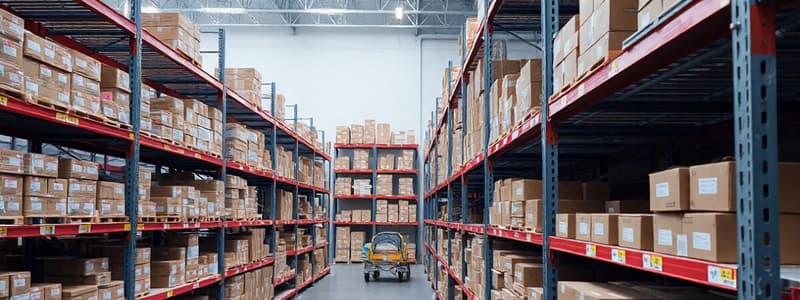Podcast
Questions and Answers
What is the definition of cycle inventory in a supply chain?
What is the definition of cycle inventory in a supply chain?
- The average inventory held in a supply chain due to the ordering of quantities that are less than the demand of the customer.
- The minimum inventory held in a supply chain over a period of time.
- The inventory held in a supply chain due to the ordering of quantities that are greater than the demand of the customer. (correct)
- The maximum inventory held in a supply chain over a period of time.
Which of the following is NOT considered a fixed cost related to lot sizing for a single product?
Which of the following is NOT considered a fixed cost related to lot sizing for a single product?
- Annual demand of the product (correct)
- Fixed cost incurred per order
- Cost per unit
- Holding cost per year as a fraction of product cost
What is the formula for calculating the cost of equity?
What is the formula for calculating the cost of equity?
- Rf - β * (Rb + MRP)
- Rf + β * (Rb - MRP)
- Rf - β * (MRP - Rb)
- Rf + β * (MRP - Rb) (correct)
Which of the following is NOT considered as a cost component of inventory holding cost?
Which of the following is NOT considered as a cost component of inventory holding cost?
What is the definition of replenishment lead time?
What is the definition of replenishment lead time?
Which of the following is an assumption made in estimating cycle inventory related costs?
Which of the following is an assumption made in estimating cycle inventory related costs?
Which of the following is NOT a factor considered in calculating ordering cost?
Which of the following is NOT a factor considered in calculating ordering cost?
What are the two main reasons why quantity discounts can increase the supply chain surplus?
What are the two main reasons why quantity discounts can increase the supply chain surplus?
What is a two-part tariff, and how does it work?
What is a two-part tariff, and how does it work?
What does a volume-based discount scheme aim to achieve?
What does a volume-based discount scheme aim to achieve?
Which of these statements accurately describes a key difference between lot size-based discounts and volume-based discounts?
Which of these statements accurately describes a key difference between lot size-based discounts and volume-based discounts?
What is the 'hockey stick phenomenon' in relation to volume-based discounts?
What is the 'hockey stick phenomenon' in relation to volume-based discounts?
How does price discrimination, as used in quantity discounts, help maximize supplier profits?
How does price discrimination, as used in quantity discounts, help maximize supplier profits?
What are the key goals of trade promotions in the context of quantity discounts?
What are the key goals of trade promotions in the context of quantity discounts?
What are the two primary options for retailers when dealing with trade promotions?
What are the two primary options for retailers when dealing with trade promotions?
Why do trade promotions generally increase cycle inventory in a supply chain?
Why do trade promotions generally increase cycle inventory in a supply chain?
What are some countermeasures to the negative impact of trade promotions on cycle inventory?
What are some countermeasures to the negative impact of trade promotions on cycle inventory?
In which situations might trade promotions still make sense?
In which situations might trade promotions still make sense?
What does aggregating multiple products in a single order aim to achieve?
What does aggregating multiple products in a single order aim to achieve?
What are the potential benefits of aggregating multiple products in a single order?
What are the potential benefits of aggregating multiple products in a single order?
How does aggregating multiple products in a single order help reduce cycle inventory?
How does aggregating multiple products in a single order help reduce cycle inventory?
What is the main difference between an all-unit quantity discount and a marginal unit quantity discount?
What is the main difference between an all-unit quantity discount and a marginal unit quantity discount?
What is the key problem with lot size-based discounts in terms of supply chain efficiency?
What is the key problem with lot size-based discounts in terms of supply chain efficiency?
What is the main goal in managing multiechelon supply chains?
What is the main goal in managing multiechelon supply chains?
Which factor is NOT mentioned as a driver for lot sizing decisions?
Which factor is NOT mentioned as a driver for lot sizing decisions?
In the integer replenishment policy, when a customer has a longer reorder interval than the supplier, what should be done?
In the integer replenishment policy, when a customer has a longer reorder interval than the supplier, what should be done?
What action is recommended if cycle inventory buildup is due to large lot sizes?
What action is recommended if cycle inventory buildup is due to large lot sizes?
Which approach is suggested to handle buildup caused by transportation?
Which approach is suggested to handle buildup caused by transportation?
What technology is recommended to address issues with order placement and receiving?
What technology is recommended to address issues with order placement and receiving?
Which of the following is NOT a method to limit forward buying in response to short-term discounts?
Which of the following is NOT a method to limit forward buying in response to short-term discounts?
If a supplier's fixed costs are excessive, what action should be taken?
If a supplier's fixed costs are excessive, what action should be taken?
How should the replenishment intervals be set across the supply chain?
How should the replenishment intervals be set across the supply chain?
Which situation would indicate that an integer replenishment policy is most beneficial?
Which situation would indicate that an integer replenishment policy is most beneficial?
Flashcards
Cycle Inventory
Cycle Inventory
Average inventory due to production or purchases in larger lot sizes than demand.
Lot Size
Lot Size
Quantity produced or purchased at a time in a supply chain.
Economic Order Quantity (EOQ)
Economic Order Quantity (EOQ)
Optimal lot size to minimize total inventory costs under steady demand.
Holding Cost
Holding Cost
Signup and view all the flashcards
Ordering Cost
Ordering Cost
Signup and view all the flashcards
Fixed Costs
Fixed Costs
Signup and view all the flashcards
Obsolescence Cost
Obsolescence Cost
Signup and view all the flashcards
Annual Demand (D)
Annual Demand (D)
Signup and view all the flashcards
Multiechelon Supply Chain
Multiechelon Supply Chain
Signup and view all the flashcards
Lack of Coordination
Lack of Coordination
Signup and view all the flashcards
Integer Replenishment Policy
Integer Replenishment Policy
Signup and view all the flashcards
Cross-Docking
Cross-Docking
Signup and view all the flashcards
Lot Sizing Decisions
Lot Sizing Decisions
Signup and view all the flashcards
Quantity Discounts
Quantity Discounts
Signup and view all the flashcards
Electronic Order Placement
Electronic Order Placement
Signup and view all the flashcards
EDLP (Every Day Low Pricing)
EDLP (Every Day Low Pricing)
Signup and view all the flashcards
Replenishment Lead Time
Replenishment Lead Time
Signup and view all the flashcards
Minimize Costs
Minimize Costs
Signup and view all the flashcards
Aggregating Orders
Aggregating Orders
Signup and view all the flashcards
Transportation Savings
Transportation Savings
Signup and view all the flashcards
All-Unit Discount
All-Unit Discount
Signup and view all the flashcards
Marginal Unit Discount
Marginal Unit Discount
Signup and view all the flashcards
Two-Part Tariff
Two-Part Tariff
Signup and view all the flashcards
Price Discrimination
Price Discrimination
Signup and view all the flashcards
Trade Promotions
Trade Promotions
Signup and view all the flashcards
Forward Buying
Forward Buying
Signup and view all the flashcards
EDLP
EDLP
Signup and view all the flashcards
Competitive Responses
Competitive Responses
Signup and view all the flashcards
Study Notes
Cycle Inventory in Supply Chains
- Cycle inventory is the average inventory held in a supply chain due to production or purchases in lot sizes exceeding customer demand.
- Lot size (Q) is the quantity produced or purchased at a time.
- Demand (D) is the demand per unit time.
Economies of Scale and Lot Sizing
- Economic Order Quantity (EOQ): A method for optimizing lot size for a single product. It minimizes annual material, ordering, and holding costs.
- Factors considered in EOQ:
- Annual demand (D)
- Fixed cost per order (S)
- Cost per unit (C)
- Holding cost per year (h) as a fraction of product cost
- Key assumptions for EOQ:
- Steady demand (D units per unit time).
- No shortages allowed.
- Fixed replenishment lead time.
Estimating Cycle Inventory Costs
- Inventory Holding Cost: Involves various costs:
- Cost of capital (influenced by equity (E), debt (D), risk-free rate (Rf), firm's beta (β), market risk premium (MRP), borrowing rate (Rb), and tax rate (t)).
- Obsolescence/spoilage costs.
- Handling costs.
- Occupancy costs.
- Miscellaneous costs (theft, security, damage, tax, insurance).
- Ordering Cost: Includes costs related to placing and receiving orders:
- Buyer time.
- Transportation costs.
- Receiving costs.
- Other related costs.
Aggregating Multiple Products
- Combining multiple products in a single order can reduce transportation and receiving costs, thus lowering cycle inventory.
- This may involve a single delivery from multiple suppliers or a single truck delivering to multiple retailers.
Quantity Discounts
- Lot size-based discounts: Discounts based on the quantity ordered in a single lot.
- Volume-based discounts: Discounts based on the total quantity purchased over a given period.
- All-unit quantity discounts.
- Marginal unit quantity discount / multi-block tariffs.
- Quantity discounts can improve coordination, increasing total supply chain profits. They can also extract surplus through price discrimination.
Two-Part Tariff
- A pricing scheme where a manufacturer charges a fixed upfront fee (franchise fee).
- This scheme can maximize coordinated supply chain profit.
Volume-Based Discounts
- Schemes aim to achieve optimal quantity purchased by retailers.
Lessons from Discounting Schemes
- Volume-based discounts are beneficial for reducing inventory and improving coordination.
- Retailers often buy more toward the end of a promotional period, a "hockey stick" phenomenon.
- Average prices for the retailers may decrease with increased purchase rates.
Price Discrimination
- Setting different prices for different units based on marginal willingness to pay maximizes profit for the manufacturer.
- Quantity discounts are a common price discrimination mechanism.
Trade Promotions
- Short-term price discounts for a limited time to induce retailer sales efforts.
- Goals include: boosting sales, shifting inventory, and defending against competitors.
- Retailers may:
- Pass through discounts to customers.
- Purchase in large quantities (forward buying).
- Trade promotions can increase cycle inventory and negatively impact performance. Strategies to counter that include:
- EDLP (everyday low pricing).
- Discounts linked to customer sell-through, not retailer buy-in.
- Scanner-based promotions.
Managing Multiechelon Cycle Inventory
- Multiechelon supply chains have multiple stages with many players. Poor coordination in lot sizing increases cycle inventory.
- Coordination across the supply chain can reduce overall costs.
Integer Replenishment Policy
- A system for synchronizing reorders within a supply chain stage and across stages using integer multiples of reorder intervals.
- This policy works best for predictable demand and high initial cycle inventory.
Managerial Levers for Reducing Cycle Inventory
- Lot sizing decisions are driven by:
- Fixed costs.
- Quantity discounts.
- Short-term discounts.
- Methods for reducing cycle inventory include:
- Reducing fixed costs, changeover times, coordinating orders, using aggregation points (e.g., milk runs).
- Employing appropriate technologies like electronic order placement, advanced shipping notices, and RFID.
- Tactics for handling short-term discounts:
- Limiting forward buys.
- EDLP.
- Linking discounts to customer sell-through, not sell-in.
- Limiting quantity purchased.
Studying That Suits You
Use AI to generate personalized quizzes and flashcards to suit your learning preferences.




